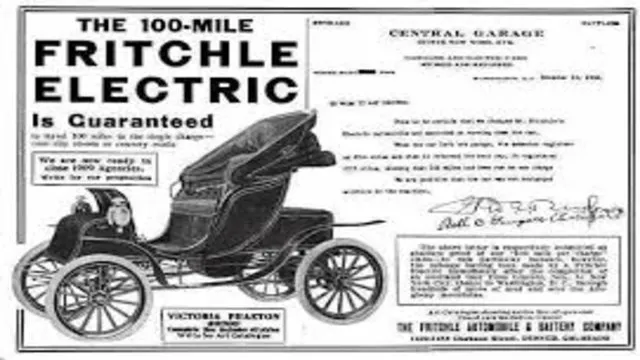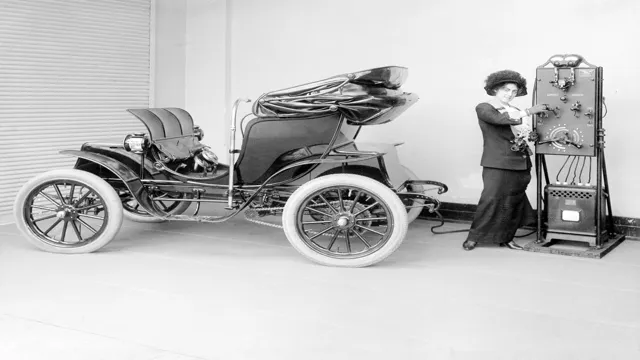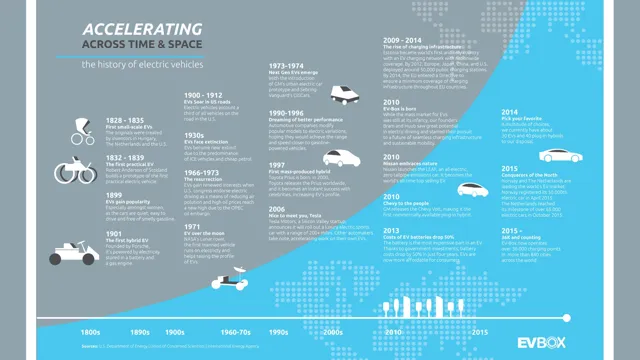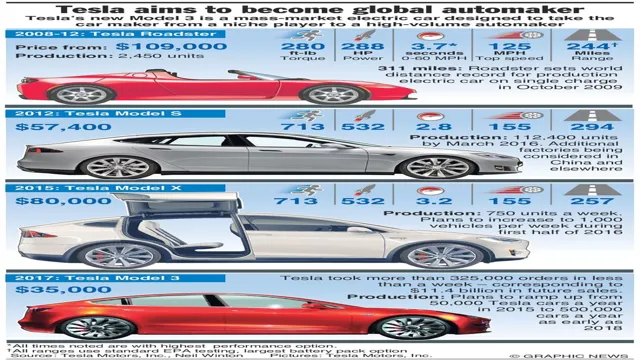Revving Up the Past: Exploring the Fascinating History of Electric and Hybrid Cars
Have you ever wondered about the inspiration behind the sleek, eco-friendly electric and hybrid cars, which are growing in popularity today? The history of electric and hybrid vehicles is fascinating, showcasing the evolution of technology throughout the years. Initially invented in the early 19th century, electric vehicles were popular in the United States, Europe, and Asia. However, they soon gave way to gasoline-powered vehicles, which were considered more convenient and practical at that time.
But as air pollution concerns and fuel efficiency gained traction in the late 20th century, electric and hybrid cars once again entered the mainstream market. Today, we witness an exciting era of technological advancements in these cars, from self-driving features to extended battery life. Let’s delve into the intriguing timeline of electric and hybrid cars, exploring the pioneering inventors, landmark developments, and future trends.
Early Innovations
The history of electric and hybrid cars dates back to the early 1800s. In 1832, Scottish inventor Robert Anderson created the first electric carriage, which relied on non-rechargeable batteries. However, the limited range of the batteries made it impractical for widespread use.
In 1899, automotive engineer Ferdinand Porsche built the world’s first hybrid car, the Lohner-Porsche Mixed Hybrid, which used an electric motor to power the car’s front wheels and a gasoline engine to power its rear wheels. Despite this early innovation, gasoline-powered cars remained dominant for most of the 20th century. It wasn’t until the 1970s oil crisis, coupled with growing environmental concerns, that interest in electric and hybrid cars began to resurface.
Today, thanks to advances in technology and an increasing focus on sustainability, electric and hybrid cars are becoming more common on our roads.
1800s – First Electric Car Invented
electric car The 1800s saw a flurry of activity in the field of automotive innovation. One of the most significant developments of the time was the invention of the first electric car. This remarkable achievement was made possible by the work of several pioneering individuals, such as Robert Anderson, Thomas Davenport, and Moses Farmer.
These visionaries and their contemporaries experimented with various forms of electric power, resulting in the creation of electric motors and batteries. In 1832, Robert Anderson created the first crude electric carriage, but it was not until the 1890s that electric cars began to see widespread use. While electric cars were initially more popular than gasoline-powered cars due to their quietness and lack of emissions, they eventually fell out of favor due to the high cost of batteries, limited range, and the rise of cheap gasoline.
Nevertheless, the electric car remained an important milestone in the development of the automobile, paving the way for future advancements in automotive technology.
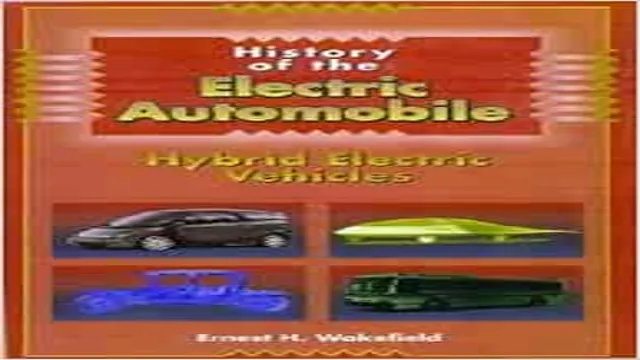
1900s – Development of Hybrid Technology
The 1900s saw groundbreaking innovations in the development of hybrid technology. One of the early pioneers of hybridization was Ferdinand Porsche, who invented the Lohner-Porsche Hybrid, which was a gasoline-electric hybrid car. This car had an electric motor in each wheel and was powered by batteries that could be recharged by an internal combustion engine.
The Lohner-Porsche Hybrid was displayed at the Paris World’s Fair in 1900 and garnered worldwide attention for its exceptional fuel efficiency. The invention of the Lohner-Porsche Hybrid proved that hybrid technology was a viable solution to reduce emissions and increase fuel efficiency, which is still relevant today. It marked the beginning of an era of research and development in hybrid technology and inspired many other inventors to come up with their own hybrid designs.
Modern Hybrid Cars
The history of electric and hybrid cars dates back to the early 19th century when the first electric carriage was invented. However, it wasn’t until the late 1990s and early 2000s that these vehicles began gaining popularity due to environmental concerns and rising gas prices. Manufacturers such as Toyota and Honda began producing modern hybrid cars that combined electric and gasoline engines to increase fuel efficiency.
Today, there is a wide range of hybrid and electric cars on the market, including plug-in hybrids and fully electric vehicles. These cars produce lower emissions and offer significant savings on fuel costs, making them an ideal choice for environmentally conscious consumers and those looking to save money on transportation expenses. While the history of electric and hybrid cars has been a long and complex one, the future looks bright for these innovative vehicles as technology continues to advance and more and more consumers seek out environmentally friendly options.
2000s – Toyota Prius Takes Market by Storm
The 2000s marked the beginning of a new era in the automotive industry, with the introduction of modern hybrid cars. The Toyota Prius took the market by storm, quickly rising in popularity due to its fuel efficiency and eco-friendliness. This new technology was a game-changer, allowing drivers to save on gas costs while reducing their carbon footprint.
The Prius was the first commercially successful hybrid car and soon became a status symbol for eco-conscious drivers. Its sleek design and advanced technology set it apart from traditional gas-powered cars, making it a desirable option for those looking to make a statement. Today, the market for hybrid cars continues to grow, with more and more manufacturers introducing their own versions.
However, the Toyota Prius will always be remembered as the car that started it all.
2020s – Rise of Electric Car Market
As we move into the 2020s, it’s clear that electric cars are becoming more popular than ever before. However, some car buyers may still be hesitant to fully commit to electric vehicles. That’s where modern hybrid cars come in.
These vehicles offer the best of both worlds, with an electric motor and a fuel-based engine working in tandem. This means that they’re more fuel-efficient than traditional gas-powered cars, but don’t require the same level of charging infrastructure as purely electric models. Modern hybrids are also a great way to dip your toe into the electric car market without fully committing.
With a range of models available from popular car manufacturers, there’s sure to be a modern hybrid that suits your needs. So whether you’re looking for a car that’s eco-friendly, fuel-efficient, or just stylish and fun to drive, a modern hybrid could be the perfect choice for you.
Statistics and Growth Trends
When it comes to modern hybrid cars, the statistics and growth trends are quite impressive. It’s no secret that more and more people are looking for ways to reduce their carbon footprint and save on gas expenses. Hybrid cars offer the perfect solution, with their fuel-efficient systems and advanced technology.
According to recent studies, the demand for hybrid cars has been steadily increasing, and it’s not hard to see why. With all the advantages they provide, it’s no wonder they’re becoming more and more popular. From the reduced emissions to the smooth and quiet driving experience, hybrid cars have something for everyone.
And with the ongoing developments in the automotive industry, we can expect even more advanced hybrid cars to hit the market soon. All in all, the statistics and growth trends for modern hybrid cars look very promising, and it’s exciting to see how they will continue to evolve in the future.
Environmental Impact
The history of electric and hybrid cars is an interesting one, dating back to the late 1800s when electric cars were first invented. However, it wasn’t until the 1990s that hybrid cars started gaining popularity due to concerns over the environmental impact of traditional gasoline-powered vehicles. Electric and hybrid cars have come a long way since then, with advancements in technology allowing for longer battery life and more efficient engines.
Today, these eco-friendly cars are more popular than ever with consumers who want to do their part in reducing their carbon footprint. By utilizing renewable energy sources, electric and hybrid cars can significantly reduce the amount of greenhouse gas emissions produced by traditional cars, making them a key player in the fight against climate change. As the demand for sustainable transportation continues to grow, we can expect to see even more innovative solutions to help reduce our impact on the environment.
Reducing Carbon Footprint
Reducing our carbon footprint is becoming increasingly important in today’s world, as we realize the devastating impact that human activities can have on the environment. Our daily actions, such as driving cars and using electricity, contribute to the release of greenhouse gases into the atmosphere, which leads to climate change and other ecological problems. It’s vital that we take steps to reduce our environmental impact, such as using public transportation, carpooling, or walking/biking instead of driving alone.
We can also reduce our carbon footprint by eating a plant-based diet and reducing our energy consumption at home. By making small changes in our daily routine, we can help to mitigate the harm that we have already caused to the planet and pave the way for a healthier, more sustainable future.
Government Incentives and Regulations
When it comes to reducing our environmental impact, government incentives and regulations can play a significant role. These incentives can be anything from tax credits to grants or subsidies that encourage businesses to invest in clean energy or eco-friendly practices. Meanwhile, regulations may limit the amount of pollution allowed in certain industries or require companies to meet specific environmental standards.
These initiatives may come with some costs, both to businesses and taxpayers, but the benefits are well worth it. By reducing our carbon footprint, we can help mitigate the effects of climate change and improve air and water quality. It’s up to all of us to do our part, but with government support in the form of incentives and regulations, we can all make a positive impact on the planet.
Future of Electric and Hybrid Cars
The history of electric and hybrid cars is one that spans over a century, starting with the first electric car hitting the roads in the late 1800s. However, it wasn’t until the 1990s that hybrid cars began to gain popularity, with the introduction of the Toyota Prius. Fast forward to present day and the future of electric and hybrid cars looks promising.
With advancements in battery technology and charging infrastructure, electric cars are becoming more practical for everyday use. In fact, major car manufacturers like Volkswagen, Ford, and General Motors have committed to transitioning to electric vehicles in the near future. The benefits of electric and hybrid cars, including reduced emissions and lower operating costs, make them an attractive option for both individuals and businesses alike.
It’s clear that the future of transportation is shifting towards sustainable technology, and electric and hybrid cars are leading the charge.
Conclusion
Thus concludes the electrifying and hybrid tale of cars! From the early beginnings of electric cars in the 19th century to the rise of hybrid technology in the 21st century, the history of these vehicles has been one of innovation, experimentation, and adaptation. While the road to widespread adoption has had its twists and turns, the future looks brighter than ever for electric and hybrid cars. So, let’s give a round of applause to the pioneers and innovators who have given us a glimpse of what’s possible on our roads, and let’s ride towards a more sustainable and electric future!”
FAQs
What is the history of electric cars?
The first electric car was invented in the 1830s, and they were popular in the early 1900s, but internal combustion engines led to their decline until the 1970s when interest began to pick up again.
When was the first commercially viable hybrid car released?
The first commercially viable hybrid car was released in 1997, and it was the Toyota Prius.
Why are electric and hybrid cars becoming more popular?
Electric and hybrid cars are becoming more popular because they are more environmentally friendly than gas-powered cars, and advancements in technology have made them more efficient and cost-effective.
How long does it take to charge an electric car?
The time it takes to charge an electric car depends on the type of charger being used and the size of the car’s battery. It can take anywhere from 30 minutes to several hours.
How do hybrid cars work?
Hybrid cars work by combining an electric motor with a gasoline engine. The electric motor can power the car at low speeds, while the gasoline engine takes over at higher speeds to provide more power. This combination leads to better fuel efficiency and lower emissions.
What is the difference between a plug-in hybrid and a regular hybrid car?
A plug-in hybrid car can be charged by plugging it into an electrical outlet, while a regular hybrid car uses regenerative braking to charge its battery while driving. Plug-in hybrids also typically have a larger battery than regular hybrids, allowing them to drive longer distances on electric power alone.

